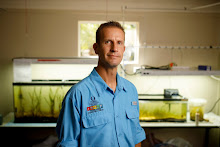Due to the COVID-19 pandemic this spring I had to switch from conventional teaching to "online instruction" halfway through the semester at Florida Gulf Coast University. Online instruction is not as efficient, effective, or fun as conventional teaching, but it IS better than nothing. One bonus of producing recorded teaching materials is that I can make them available for free to interested members of the public. I have done this with the lectures for my Marine Ecology course "OCB4633C." This is a required course in the BS Marine Science program at colleges in the Florida State University system. I recorded the lectures by doing "voice overs" of my existing PowerPoint slideshow presentations, then converting the presentations to video and uploading them to YouTube. The voice over recording function in powerpoint also lets you use a "laser pointer" or "pen" tool to scribble on the slides as you talk, so I did a lot of that.
These presentations are not National Geographic quality, and some of them move a little slowly with an inordinate amount of "ums" and "ok, so"s. Anyway, with those disclaimers done, here are the videos, in the order that I would normally present these topics to the students. Please let me know if you have any questions or comments, if you note mistakes or unclear segments, etc.
Introduction and Patterns in the Marine Environment
Intertidal Ecology
Primary Production Pt. 1
Primary Production Pt. 2
Secondary Production
Microbial Ecology
Pelagic Ecosystems
Continental Shelf Ecosystems
Estuaries
Seagrass, Saltmarsh, and Mangrove Ecosystems
Coral Reef Ecosystems
Deep Sea Ecology
Foodwebs, Biodiversity, and Ecosystem Functions (this one is long with a lot of theory; casual watchers may want to skip or save for last)
Fisheries Ecology
Aquaculture (aka Fish Farming)
Disturbance Ecology
Pollution and Climate Change
Saturday 12 27 25 morning call
3 hours ago

6 comments:
Just watched the first lecture. You're a good presenter! No reading off the slides, just lots of great added info and explanations of them. Easy to follow and I was never bored or at risk of losing interest. I've had a lot of college professors in my life and can say I enjoy your teaching style so far. I'd say I bet days out in the field with you would be fun but I already know that from the times we've snorkeled and paddled together haha.
Thanks, Matt! Yeah, I definitely try to use my slides as visual aids but avoid directly reading off them.
In the "estuaries" video, around 47 minutes in, there is a slide that mentions mangroves taking up CDOM "especially in the presence of crabs." Just out of curiosity, could you expand on what the connection is there between the crabs and mangroves that results in more CDOM being taken up?
Good eye, Matt. I'm actually not sure what scientific study that "crabs help mangroves absorb CDOM" thing comes from, nor am I sure about what the mechanism is. I might speculate that by burrowing, crabs increase sediment infiltration of water and solutes like oxygen and CDOM, and that facilitates some kind of magic CDOM processing within the root and sediment microbial community.
Hi and thank you for making this available.
There are two more recordings on youtube than here:
- Microbial Ecology and Ocean Chemistry;
- Secondary Production;
Where do they fit in the sequence?
Thank you in advance.
Hi David- Thanks for pointing out the missing two! I've added them in now. -J
Post a Comment